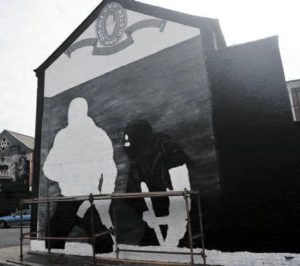
Il politico, parlando in forma anonima, rivela che “una fonte informata sulla sicurezza” parla di “elementi di UDA e UVF che osservano la minaccia repubblicana”.
Il politico non suggerisce una rottura imminente al cessate-il-fuoco delle formazioni lealiste, ma esprime timore che possa accadere.
“Potrebbero fare qualcosa di stupido? Non sono sicuro”, ha detto il politico.
La valutazione sarebbe che l’UDA è stabile ma l’UVF sarebbe “sotto pressione” affinché lanci un attacco.
Ha indicato una combinazione di fattori – l’attività repubblicana, le indagini dell’HET e le speculazioni sul processo che coinvolge un’importante figura dell’UVF, vicina al centro decisionale dell’organizzazione, adesso divenuto un “supergrass” – un paramilitare pentito che divulga l’identità degli ex commilitoni.
Ha avvertito: “Se si gratta la crosta ci si infetta”.
Ha detto che l’UVF potrebbe pensare: “Se colpisci, ottieni maggior simpatia dal governo?”
Una figura di leadership paramilitari ha detto questo al Belfast Telegraph che il Combined Loyalist Military Command (CLMC) non si è ancora riunito.
“Se ne parla”, ha continuato. “Ma non è ancora successo”.
Alla domanda sullo scopo di tale incontro, ha risposto: “Tutte queste cose citate potrebbero essere all’ordine del giorno.”
Il CLMC è un gruppo lealista ombrello che riunisce le dirigenze UDA, UVF e Red Hand Commando.
E’ stato il nome con cui è stato annunciato il cessate-il-fuoco lealista nell’ottobre 1994, e la struttura paramilitare è stata utilizzata per pianificare le mosse verso lo smantellamento degli arsenali.
Sulla questione delle continue indagini sulla violenza pre-cessate-il-fuoco e pre-Accordo del Venerdì Santo, un leader paramilitare ha detto: “Tutti sono preoccupati dell’Historical Enquiries Team.
“Ha bisogno di essere controllato”.
Alla domanda se esiste un nervosismo specifico all’interno della UVF per queste indagini, ha risposto: “C’è sicuramente”.
La fonte ha detto che l’organizzazione paramilitare ha avuto anche problemi interni a livello di leadership, in particolare nella di East Belfast.
“Sta solo facendo le sue cose”, ha detto la fonte, in un riferimento al leader UVF in quella parte della città.
C’è stato un esempio nel periodo precedente le ultime elezioni per Stormont e per il governo locale, quando due murales UVF sono stati dipinti in Newtownards Road, a East Belfast.
Il soggetto comprende uomini in passamontagna armati di fucili – murales progettati per offrire un messaggio di guerra.
Fears over loyalist ceasefire
The politician, speaking on condition of anonymity, said “an informed security source” had revealed that “elements of the UDA and UVF were looking at the dissident threat”.
The politician was not suggesting an imminent threat to the loyalist ceasefires, but expressing fears about what could happen.
“Would it result in them doing something stupid? I’m not sure,” the politician said.
He said the assessment was that the UDA was stable but the UVF was “under pressure” to launch an attack.
He pointed to a combination of factors — dissident activity, HET investigations and speculation about a “supergrass” trial involving a one-time senior UVF figure close to the decision-making centre of the organisation.
He warned: “If you pick that scab you infect it.”
He said the UVF could be thinking: “If you strike, do you get more Government sympathy?”
A paramilitary leadership figure told this newspaper the Combined Loyalist Military Command (CLMC) has not met.
“It’s being talked about,” he continued. “But it hasn’t happened yet.”
Asked about the purpose of any such meeting, he replied: “All of those things mentioned could be on the agenda.”
The CLMC is an umbrella loyalist leadership that pulls together the UDA, UVF and associated Red Hand Commando.
It was the title under which the loyalist ceasefire was announced in October 1994, and the paramilitary structure was used to plan moves towards decommissioning.
On the question of continuing investigations into pre-ceasefire and pre-Good Friday Agreement violence, a paramilitary leadership figure said: “Everybody is worried about the HET.
“It needs to be looked at.”
Asked was there a specific nervousness within the UVF about these investigations, he replied: “There definitely is.”
The paramilitary source said the organisation also had internal problems at leadership level, particularly in east Belfast.
“He’s just doing his own thing,” the source said, in a reference to the UVF leader in that part of the city.
There was an example of this in the period leading up to the recent Stormont and local government elections when two UVF murals were painted on the Newtownards Road in east Belfast.
They showed men in balaclavas carrying guns — paintings designed to deliver a war message.